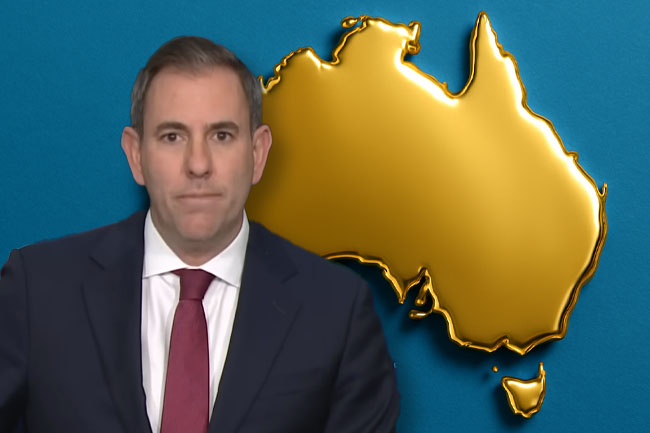Australia provided the world a positive case study through the global financial crisis. Now, it's providing a highly negative example. Alan Austin reports.
WHAT IS THE BEST rate of company tax for a smoothly-running economy? That is the question underlying intense political debate in several countries today.
The number, of course, won’t be the same everywhere. But the answer is pretty clear for Australia — which could be a handy case study for other countries.
And the answer is... about 30%.
The rationale is a simple one. During the deep recession following the 2008 onset of the global financial crisis (GFC), there was one stand-out economy — Australia. Of the 35 wealthy, capitalist member countries of the Organisation for Economic Cooperation and Development (OECD), only a few averted a full recession — defined as two consecutive quarters of negative quarterly growth in gross domestic product (GDP).
But Australia alone also avoided deep job losses and a full year of negative GDP growth. Australia, almost alone, with Mexico, maintained interest rates within the optimum band of 2.8% to 4.8%. Australia was the only country to gain AAA credit rating through the worst global recession in 80 years.
So what did Australia do differently to generate the world’s best-performed economy from 2010 to 2013? Several things. There was no single magic bullet. Among the strategies which seem to have served well was maintaining corporate tax rates at the 30% level.
Countries that responded to the onset of the GFC by slashing corporate taxes all suffered badly. Those which kept the rates at around 30%, or increased them towards that level, fared much better.
Canada cut its corporate rate from 34% in 2007 progressively down to 26.1% by 2012. The jobless rate rose from below 6.0% to 8.7%, debt blew out to 85% of GDP and the recession lasted three quarters.
The United Kingdom slashed its company tax rate from 30% to 26% and then to 21%. The jobless rate rose from 5.2% to 8.0% and the debt blew out from 35% of GDP to above 80%. Its recession lasted five quarters.
Finland, Sweden and the Czech Republic all slashed their company tax rates and then watched in dismay as their jobless rates soared, their debts ballooned and their recessions deepened. Five negative quarters in Finland, four in Sweden and three in the Czech Republic.
"If you want to stimulate the economy, increase the minimum wage." @jasonballau offers an alternative to company tax cuts after today's Senate inquiry #auspol #TheDrum pic.twitter.com/zAmEW63kpr
— ABC The Drum (@ABCthedrum) April 24, 2018
Young Australian of the Year Jason Ball discusses alternative options for company tax cuts (video via Twitter).
Intriguingly, some countries cut the corporate rate, but swiftly changed their minds. Iceland dropped its rate from 18% to 15% in 2008, then reversed the decision and increased it to 20%. Israel, Greece and Luxembourg also cut the rates but soon restored them.
The evidence through the Financial Crisis confirms cutting company tax was not helpful. But what about during the recovery phase after? Here, again, Australia leads by example — although in this case, it is a highly negative one.
After the 2013 change of government, Australia’s official corporate rate remained on the books at 30%. But collections from the corporations collapsed.
Incoming Prime Minister Tony Abbott signalled that companies would not be required to pay the 30%, but could determine their own level themselves: Australia is open for business (nudge nudge, wink wink); lower taxes, less red tape are the key (if you get my drift); and the Coalition is Liberal in the sense that we believe in lower taxes, smaller government and greater freedom (say no more, say no more).
With these not-so-subtle hints came the actions of removing several thousand workers from the Australian Taxation Office, including many working in corporate compliance and framing tax cut legislation.
The Australian Bureau of Statistics (ABS) has reported what happened to collections. Its quarterly file on business indicators shows gross profits generated in Australia. Its annual taxation update shows company tax collected.

(Graph via Trading Economics.)
These two match up pretty well over the 15 years since the corporate rate was reduced to 30%. There is a remarkable evenness in tax paid as a proportion of profits. Except for two intervals.
The first exceptional period, unsurprisingly, is the four years from 2008-09 to 2011-12 of the GFC. The second is the last four years — the strongest boom in global trade and corporate profits since World War II. Both times, company tax collections collapsed.
The deep shortfall in collections over the last four years – when the rate was not changed and when profits reached new records – confirms what we have learned from the ATO annual reports, transparency reports and former ATO executives: that evasion has escalated.
This ABS data enables us to quantify the losses to the Federal budget — and to the people of Australia. In 2013-14, the shortfall was $8.2 billion; in 2014-15, it was $7 billion; in 2015-16, it was $8.3 billion; and, in 2016-17, the loss was $9.1 billion. Hence, the total four-year loss was $32.6 billion.
So what has happened to the economy over those four years of effective corporate tax cuts? Has that $32.6 billion retained by the corporations led to new investment, more jobs, economic growth and higher wages?
The evidence is clear. The opposite has eventuated. Jobs have deteriorated badly, with more than 730,000 people still unemployed and another million or so underemployed. Australia’s ranking on jobs in the world has plummeted, from near the top to equal 71st now. Equal with Indonesia.

(Graph via Trading Economics.)
Economic growth has stagnated, with Australia’s world ranking now at equal 125th. Equal with Somalia. Gross government debt has blown out by $254 billion to a staggering $524 billion and Australia’s net worth has plummeted to negative $407.3 billion.
Other variables to have deteriorated badly include wages, productivity, construction, infrastructure, national income and the value of the Aussie dollar.
If the world wants to see what happens when a sound economy reduces its corporate taxes collections, they need look no further.
You can follow Alan Austin on Twitter @AlanAustin001.
 This work is licensed under a Creative Commons Attribution-NonCommercial-NoDerivs 3.0 Australia License
This work is licensed under a Creative Commons Attribution-NonCommercial-NoDerivs 3.0 Australia License
Support independent journalism Subscribe to IA.












